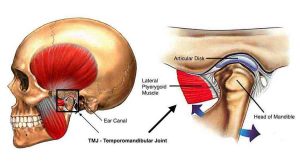What are TMJ Disorders?
 The temporomandibular (tem-puh-roe-man-DIB-u-lur) joint (TMJ) is a joint that connects your jawbone to your skull. TMJ disorders can cause pain in the jaw, neck, ears, head and shoulders. For some people, TMJ disorders can even cause pain or locking of the joint when eating or yawning. According to the Mayo Clinic, “the exact cause of a person’s TMJ disorder is often difficult to determine. Your pain may be due to a combination of factors, such as genetics, arthritis or jaw injury.”
The temporomandibular (tem-puh-roe-man-DIB-u-lur) joint (TMJ) is a joint that connects your jawbone to your skull. TMJ disorders can cause pain in the jaw, neck, ears, head and shoulders. For some people, TMJ disorders can even cause pain or locking of the joint when eating or yawning. According to the Mayo Clinic, “the exact cause of a person’s TMJ disorder is often difficult to determine. Your pain may be due to a combination of factors, such as genetics, arthritis or jaw injury.”
How can physical therapy help with TMJ disorders?
Physical therapy includes a comprehensive evaluation of the patient’s symptoms, medical history and needs. Then the physical therapist will develop and individualized treatment plan to improve and restore normal function of the neck and jaw. Many different types of treatment may be used to help TMJ disorders, including biofeedback, neuromuscular re-education, relaxation techniques, diaphragmatic breathing, exercises to improve range of motion and strength, jaw stabilization and manual therapy. Manual therapy may include Soft Tissue Mobilization or STM, Myofascial Release or MFR, and Trigger Point Release or TP. In addition, posture and ergonomic training and oral habit awareness to reduce clenching and grinding habits can help reduce the stress on the TMJ. Through a combination of joint exercises, massage, breathing exercises, and manual therapy, patients can experience relief from pain and improved quality of life.
Can my dentist help with my TMJ disorder?
Many people may discuss their temporomandibular disorder (TMD) with their dentists; however, many dentists will then refer the patient to do physical therapy to help with the disorder, in addition to encouraging use of a nighttime mouth guard. According to the National Institute of Health, “Although routinely managed by medical and dental practitioners, TMD may be more effectively cared for when physical therapists are involved in the treatment process. Although routinely managed by medical and dental practitioners, TMD may be more effectively cared for when physical therapists are involved in the treatment process.” By discussing your TMJ disorder with your dentist or doctor and seeking physical therapy in addition to that, patients will receive the most effective care for their condition. Physical therapists will work with patients to complete exercises during the session, as well as give patients exercises to work on at home in order to see the most progress in their treatment program. Posture, jaw and neck exercises and stretching are the most common that patients can do at home to further their therapy program.
What should I expect at my fist appointment?
When patients first arrive, they will fill out paperwork about medical history and insurance information. The patient will then undergo an evaluation with a licensed therapist or therapy assistant that will determine the best course of therapy for the individual patient based on their symptoms, medical history and goals for therapy. The patient will then begin exercises that will get them started on their therapy goals. Patients will also be sent with exercises to do at home that will further their progress of their therapy goals.
How long with a course of therapy for TMJ disorders last?
For many people, a course of physical therapy for TMJ disorders may last 6-8 weeks or longer, if needed. Every patient is provided a course of therapy that fits their individual needs and ensures their therapy goals are met and they have relief from their pain.
Find relief today and contact us for TMJ Therapy
